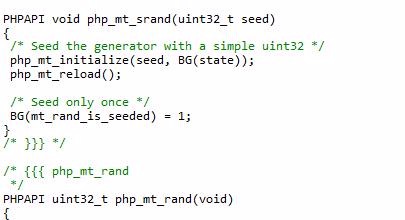Detailed explanation of the introduction and usage of rand function
The following is a detailed explanation of the difference between numpy.random.randn() and rand(). It has a good reference value and I hope it will be helpful to everyone. Let’s take a look. There are some commonly used functions in numpy to generate random numbers, randn() and rand() are among them. numpy.random.randn(d0, d1, …, dn) returns one or more sample values from the standard normal distribution. The random sample of numpy.random.rand(d0, d1, …, dn) is in [0, 1). import numpy as np arr1 = np.random.randn(2,4) print(arr1) print('************************************************ *******************') arr2
1. Detailed explanation based on the difference between numpy.random.randn() and rand()
Introduction: The following is for everyone Share a detailed explanation based on the difference between numpy.random.randn() and rand(). It has a good reference value and I hope it will be helpful to everyone. Let’s take a look together
2. Detailed explanation of safe examples of mt_rand() random numbers in PHP

Introduction: A lot of security vulnerabilities related to mt_rand() were discovered some time ago, and they were basically caused by misunderstanding the usage of random numbers. Here I would like to mention another pitfall of the PHP official website manual. Take a look at the introduction to mt_rand(): Chinese version ^cn English version ^en. You can see that the English version has an extra yellow Caution warning. mt_rand() uses the mersennetwister algorithm to return random integers. Everyone knows this, but the following article mainly introduces you to the relevant information about the security of mt_rand() random numbers in PHP. The introduction in the article is very detailed. Friends who need it can refer to it. For reference, let’s learn with the editor below.
3. Detailed explanation of Python’s random module
Introduction: This article mainly introduces the relevant content of Python’s random module. It has certain reference value. Friends who need it can refer to it. I hope it can help everyone.
4. php random number generated rand() function
Introduction: I believe everyone is familiar with the rand() function It is not unfamiliar. Many friends have come to this function during the development process. They all know that this function generates PHP random numbers. The rand() function returns an integer of PHP random numbers! Today I will take you to learn more about the rand() function of random number generation in PHP!
Introduction: The array_rand() function returns a random key name in the array, or if the specified function returns more than one key name, returns an array containing random key names.
6. php function array_rand that rearranges the elements in the array in random order
Introduction: random extraction It is to scramble the elements of the original array and output them. This means that after each execution, the order or elements extracted are different. This function can be used to display different advertisements on the web page each time. Use the array_rand() function to implement the array. Random extraction:
7. In-depth understanding of mt_rand() random number security in php

Introduction: mt_rand() uses the mersennetwister algorithm to return random integers. Everyone knows this, but the following article mainly introduces you to the security of mt_rand() random numbers in PHP. The information is introduced in great detail in the article. Friends who need it can refer to it. Let’s learn together with the editor.
 ##
##
Introduction: This article mainly introduces how Java uses Math.random() combined with the Monte Carlo method to calculate the pi value. It briefly explains the principle of the Monte Carlo method combined with specific examples, and combines the specific example forms. Analyzed the operation skills of Java using Monte Carlo method to calculate PI value. Friends in need can refer to
9. How to use Math.random() and Monte Carlo in Java Method to calculate the case of pi value

##Introduction: This article mainly introduces the use of Math.random( in Java ) combined with the Monte Carlo method to calculate the PI value, briefly explains the principle of the Monte Carlo method combined with specific examples, and combines the specific examples to analyze the operating skills of Java using the Monte Carlo method to calculate the PI value. Friends in need can refer to Next
10. Explanation of methods and principles of java.util.Random implementation

Introduction: The class java.util.Random in the Java utility class library provides methods for generating various types of random numbers. The following article mainly introduces you to java.util The relevant information on the implementation principle of .Random is introduced in detail through sample code in this article. Friends in need can refer to it.
11. Comparison of the differences between the php rand() function and the mt_rand() function
Introduction: mt_rand() Four times faster than rand(), many old libc random number generators have some uncertain and unknown characteristics and are very slow. PHP's rand() function uses the libc random number generator by default. The mt_rand() function is informally used to replace it.
12. Comparison of the differences between rand() function and mt_rand() function in php
Introduction: mt_rand( ) is four times faster than rand(). Many old libc random number generators have some uncertain and unknown characteristics and are very slow. PHP's rand() function uses the libc random number generator by default. The mt_rand() function is informally used to replace it.
13. php function mt_rand() and rand() performance test comparison example detailed explanation

Introduction: This article uses examples to compare and analyze the performance issues of random functions mt_rand() and rand() in PHP. Share it with everyone for your reference. The specific analysis is as follows: In php, the mt_rand() and rand() functions can randomly generate a pure number. They both require us to set the seed data and then generate it, then
14. JAVA’s Random class, array learning
Introduction: Random tool class Function: Generate a random number Usage steps: 1. Import the corresponding package import java.util.Random; 2. Create a reference type variable data type variable name = new data type (); Random rd = new Random(); 3. Call the function variable name. The function generates a random integer in the range [0,n), and generates a random integer that contains 0, but does not
##15.Recommended 10 articles about rand

16.
10 recommended articles about array_rand() Introduction: shuffle() definition and usage The shuffle() function rearranges the elements in the array in random order. Returns TRUE if successful, otherwise returns FALSE. Note: This function assigns a new key name to the unit in the array. This will delete the original keys rather than just reorder them. Note: As of PHP 4.2.0, it is no longer necessary to seed the random number generator with the srand() or mt_srand() functions, it is now done automatically. Words... 17. 10 recommended articles about the php srand() function Introduction: shuffle() definition and usage shuffle() function rearranges the elements in the array in random order. Returns TRUE if successful, otherwise returns FALSE. Note: This function assigns a new key name to the unit in the array. This will delete the original keys rather than just reorder them. Note: As of PHP 4.2.0, it is no longer necessary to seed the random number generator with the srand() or mt_srand() functions, it is now done automatically. Words... 18. 10 recommended articles about the php rand() function Introduction: shuffle() definition and usage shuffle() function rearranges the elements in the array in random order. Returns TRUE if successful, otherwise returns FALSE. Note: This function assigns a new key name to the unit in the array. This will delete the original keys rather than just reorder them. Note: As of PHP 4.2.0, it is no longer necessary to seed the random number generator with the srand() or mt_srand() functions, it is now done automatically. Words... 19. Summary of the usage of mt_srand function Introduction: shuffle() definition and usage shuffle() function rearranges the elements in the array in random order. Returns TRUE if successful, otherwise returns FALSE. Note: This function assigns a new key name to the unit in the array. This will delete the original keys rather than just reorder them. Note: As of PHP 4.2.0, it is no longer necessary to seed the random number generator with the srand() or mt_srand() functions, it is now done automatically. Words... 20. 10 recommended articles about the php mt_srand() function Introduction: shuffle() definition and usage shuffle() function rearranges the elements in the array in random order. Returns TRUE if successful, otherwise returns FALSE. Note: This function assigns a new key name to the unit in the array. This will delete the original keys rather than just reorder them. Note: As of PHP 4.2.0, it is no longer necessary to seed the random number generator with the srand() or mt_srand() functions, it is now done automatically. Words... 21. 10 recommended articles about the php mt_rand() function Introduction: This article collects several articles about the php mt_rand function. You are welcome to watch and collect 1. Introduction to php generating random numbers from 0 to 1 (decimal): function randomFloat($min = 0, $max = 1) { return $min mt_rand() / mt_getrandmax() * ($max - $min); } &nbs... 22. Recommended articles about getrandmax 简介:本篇文章收集了几篇关于php getrandmax()函数的文章,欢迎大家观看收藏1. php生成0到1(小数)的随机数简介:function randomFloat($min = 0, $max = 1) { return $min + mt_rand() / mt_getrandmax() * ($max - $min); } &nbs... 简介:本篇文章收集了几篇关于php getrandmax()函数的文章,欢迎大家观看收藏 24. 关于randrange的详细介绍 简介:从函数签名中我们可以知道:In [7]: random.randrange?Signature: random.randrange(start, stop=None, step=1, _int=<type 'int'>, _maxwidth=9007199254740992L)Doc... 25. 关于random()的详细介绍 简介:这篇文章主要介绍了Python随机生成数模块random使用实例,本文直接给出示例代码,需要的朋友可以参考下代码如下:#!/usr/bin/env python#coding=utf-8import random#生成[0, 1)直接随机浮点数print random.random()#[x, y]中的随机整数print rand... 【相关问答推荐】: php - frameset中本页面的跳转会跳转到首页怎么处理?










Hot AI Tools

Undresser.AI Undress
AI-powered app for creating realistic nude photos

AI Clothes Remover
Online AI tool for removing clothes from photos.

Undress AI Tool
Undress images for free

Clothoff.io
AI clothes remover

AI Hentai Generator
Generate AI Hentai for free.

Hot Article

Hot Tools

Notepad++7.3.1
Easy-to-use and free code editor

SublimeText3 Chinese version
Chinese version, very easy to use

Zend Studio 13.0.1
Powerful PHP integrated development environment

Dreamweaver CS6
Visual web development tools

SublimeText3 Mac version
God-level code editing software (SublimeText3)

Hot Topics
 1378
1378
 52
52
 Detailed explanation of how to use MyBatis batch delete statements
Feb 20, 2024 am 08:31 AM
Detailed explanation of how to use MyBatis batch delete statements
Feb 20, 2024 am 08:31 AM
Detailed explanation of how to use MyBatis batch delete statements requires specific code examples. Introduction: MyBatis is an excellent persistence layer framework that provides rich SQL operation functions. In actual project development, we often encounter situations where data needs to be deleted in batches. This article will introduce in detail how to use MyBatis batch delete statements, and attach specific code examples. Usage scenario: When deleting a large amount of data in the database, it is inefficient to execute the delete statements one by one. At this point, you can use the batch deletion function of MyBatis
 Introduction to the latest functions of PHP 7.3: Make your programming more efficient
Jun 27, 2023 am 11:25 AM
Introduction to the latest functions of PHP 7.3: Make your programming more efficient
Jun 27, 2023 am 11:25 AM
As a widely used programming language, PHP is constantly evolving and adding new features. In early 2019, PHP 7.3 version was grandly launched, including many eye-catching new functions and features. In this article, we will introduce you to some of the latest functions of PHP7.3. We hope that these new functions can make your programming more efficient. is_countable function The new function is_countable can determine whether a variable has a counting function. Returns true if the variable can be counted
 Detailed explanation on how to download and use the win10 installation tool
Jul 14, 2023 am 10:53 AM
Detailed explanation on how to download and use the win10 installation tool
Jul 14, 2023 am 10:53 AM
For computer novices, reinstalling the system is not an easy task. What should some netizens do if they want to install win10 system but they don’t know how to install win10 system. We can easily achieve the purpose of installing the system with the help of the win10 installation tool. The following editor will teach you how to download and use the win10 installation tool. We can use the Magic Pig one-click system reinstallation tool to upgrade and install the win10 system online. Please refer to the specific installation steps: 1. First download and install the Magic Pig one-click system reinstallation software and open it. Select the win10 system and click to start the installation. Be careful to turn it off. Avoid being blocked by your computer’s anti-virus software. 2. Wait patiently for the software to download the windows system image data, etc. 3. After the deployment is completed, you can choose to re-
 PHP function introduction: str_replace() function
Nov 03, 2023 pm 06:09 PM
PHP function introduction: str_replace() function
Nov 03, 2023 pm 06:09 PM
Introduction to PHP functions: str_replace() function, specific code examples are required. PHP is a popular server-side scripting language that is often used for website development. In PHP, there are a large number of functions that can be used to extend the functionality of the website. One of them is the str_replace() function, which is used to replace substrings in a string. This article will introduce the usage of str_replace() function and provide some specific code examples. The syntax of str_replace() function is as follows: str_re
 Introduction to Python functions: Introduction and examples of hasattr function
Nov 03, 2023 pm 12:06 PM
Introduction to Python functions: Introduction and examples of hasattr function
Nov 03, 2023 pm 12:06 PM
Introduction to Python functions: Introduction and examples of hasattr function In Python, hasattr() is a built-in function. Its main function is to check whether an object has a specified property or method and return a Boolean value to indicate whether it exists. The use of this function is very simple, only need to provide two parameters: an object and a string. Returns True if this object has the same properties or methods as the string, False otherwise. Let’s introduce this function in detail below
 Introduction to the usage of PHP's array_filter() function
Jun 27, 2023 am 11:50 AM
Introduction to the usage of PHP's array_filter() function
Jun 27, 2023 am 11:50 AM
In PHP programming, array is a very common data type. Filtering and filtering arrays is one of the common operations. At this time, you can use the array function array_filter() provided by PHP. This article will introduce and demonstrate the usage of this function. 1. Basic usage of the array_filter() function. The function of the array_filter() function is to filter and filter the array. Its basic syntax is as follows: arrayarray_filter(array
 Introduction to PHP functions: array_column() function
Nov 03, 2023 pm 07:42 PM
Introduction to PHP functions: array_column() function
Nov 03, 2023 pm 07:42 PM
PHP function introduction: array_column() function introduction: In PHP programming, we often need to extract the value of a specific key from a multi-dimensional array, then we can use the array_column() function. This article will introduce the usage and code examples of the array_column() function in detail. The array_column() function is a function only available in PHP version 5.5.0 and above. It can extract the value of the specified key from a multi-dimensional array and return a one-dimensional array containing the specified key value.
 PHP function introduction: array_unique() function
Nov 04, 2023 am 10:09 AM
PHP function introduction: array_unique() function
Nov 04, 2023 am 10:09 AM
PHP function introduction: array_unique() function, specific code examples are required. In PHP programming, we often need to operate and process arrays. One of the commonly used functions is the array_unique() function, which allows us to remove duplicate elements from an array and return a new array. The syntax of the array_unique() function is as follows: array_unique(array$array,int$sort_flag=SO



